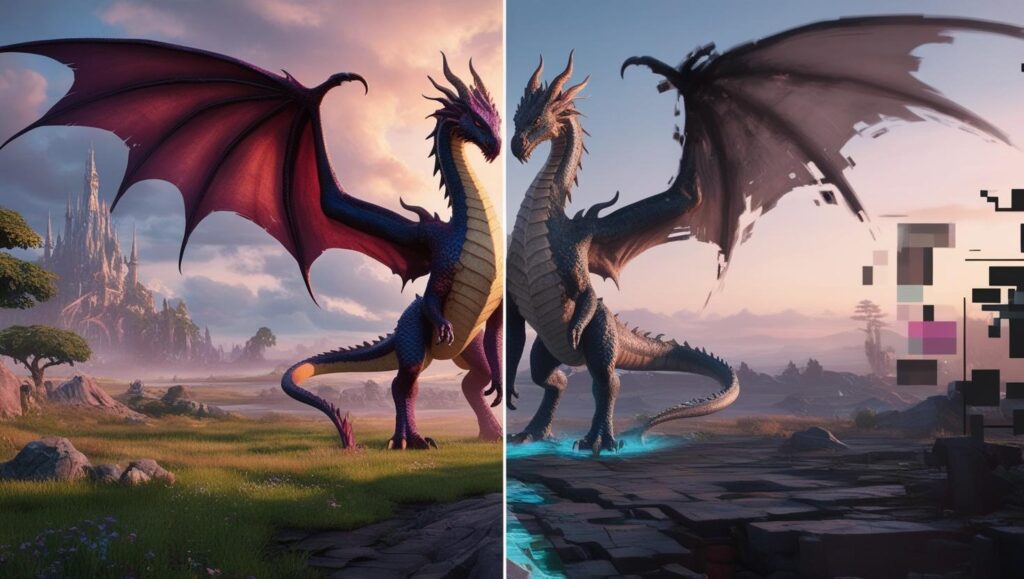
The rise of AI tools like Midjourney, Stable Diffusion, and DALL·E has shaken the creative foundations of the game development industry. In a matter of seconds, these tools can conjure up stunning environments, dynamic characters, and imaginative creatures — all without a human holding a pencil.
But while AI-generated art opens doors, it also comes with its fair share of dead ends, especially for game developers. As someone who’s been in the trenches of game art for a decade, I’ve seen firsthand how AI can both accelerate ideation and derail production.
So let’s break it down: when it works, when it fails, and how to ethically and practically use AI-generated art in game development.
✅ When AI-Generated Art Works for Game Development
1. Concept Art & Visual Brainstorming
AI excels at quick ideation. Want five variations of a cyberpunk alley at night? Prompt it, and in under a minute you have a visual palette.
- Use Case: Establishing mood boards, testing themes (e.g., “abandoned underwater labs” or “lava-drenched fantasy castles”).
- Why it works: AI skips over the time-consuming sketch phase. It’s a perfect pre-production tool.
- 💡 Pro Tip: Use Midjourney’s aspect ratio prompts (
--ar 16:9,--ar 3:4) to tailor your concept art for environment or character sheets.
2. Inspiration for Character Design
While AI still struggles with consistent anatomy, it can inspire ideas for armor sets, fashion design, or color schemes.
- Use Case: Generating dozens of looks for a rogue AI villain or fantasy mage without exhausting your team.
- Why it works: Gives artists a jumping-off point for refinement.
3. Mood Illustrations for Lore or World-Building
If your game includes codex entries, cutscene backgrounds, or lore pages, AI art can produce visually rich pieces that enhance storytelling.
- Use Case: Background stills, flavor visuals in menus, or cinematic static shots.
❌ When AI Fails — And You Should Avoid It
1. Game-Ready Assets
AI cannot produce clean, animatable sprites, layered PSDs, or modular 3D-ready content.
- Issue: The output is flattened and static. It’s beautiful but unusable in production without heavy editing.
- Example: An AI-generated character might have 6 fingers or weapons that melt into their body.
2. Consistency Across Frames
If you’re developing a sprite sheet or animated sequence, AI won’t deliver consistent poses or facial expressions across frames.
- Issue: Lack of cohesion. One frame might look cool; five together look like a different character each time.
- Workaround: Use AI only for static images or design inspiration — not for any in-engine animation use.
3. Legal & Ethical Gray Areas
One of the most hotly debated issues — and rightly so.
- Copyright Concerns: Many AI datasets are trained on copyrighted art without permission.
- Indie Dev Risk: You might unknowingly use art that resembles a known IP or artist’s style too closely.
- Platform Policy: Some marketplaces (like Steam or Epic) are cracking down on unedited AI content.
🧼 How to Clean, Modify & Make AI Art Production-Ready
If you’re using AI art, never ship it raw. Here’s how pros use it safely and ethically:
Step 1: Use It as a Sketch Layer
Import the image into Photoshop, Krita, or Procreate. Trace, correct anatomy, and rebuild parts.
Step 2: Overpaint Key Areas
Repaint faces, hands, weapons, and lighting. This ensures your final image isn’t a 1:1 derivative.
Step 3: Add Custom Textures or Assets
Overlay your own brushwork, 3D renders, or photo textures to “break the AI fingerprint.”
Step 4: Keep Source Prompts + Metadata
For transparency and future use, keep logs of your prompts and any models used (e.g., Midjourney v6, SDXL with a specific LoRA).
⚖️ The Ethics: Where Do We Draw the Line?
I believe the future is hybrid. AI isn’t here to replace artists — it’s here to remove blank canvas syndrome, to fuel rapid ideation, and to speed up iteration cycles.
But:
- Don’t use AI as a shortcut to avoid hiring artists.
- Don’t submit AI art to contests, stores, or clients without disclosure.
- Do use AI to prototype smarter, faster, and cheaper — but finish with a human touch.
- 🧠 Remember: Great games are built on heart, not just prompts.
🔚 Final Thoughts
AI tools are just that — tools. In the right hands, they can revolutionize your pipeline. In the wrong hands, they result in sloppy work, legal headaches, and ethical backlash.
The best game developers in 2025 are the ones who understand how to wield these tools without losing the soul of their art.
Have you used AI art in your game dev process? Share your experiences or ethical concerns in the comments below 👇
👏👌🙌